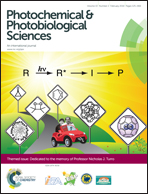Different sensing modes of fluoride and acetate based on a calix[4]arene with 25,27-bistriazolylmethylpyrenylacetamides†‡
Abstract
25,27-Bis{1′-N-(1-pyrenyl)-aminocarbonylmethyl-1H-[1′,2′,3′]tri-azolyl-4′-methoxy}-26,28-dihydroxycalix[4]arene, 4, is synthesized as a fluorescent chemosensor for the selective detection of both anions and ion pairs in MeCN. Sensor 4 uses bis-triazoles as ligands to bind a metal ion, bis-amides and bis-triazoles as the sites to recognize anions, and pyrenes as fluorophores. Among eight anions screened, chemosensor 4 showed a marked fluorescence change toward F−, H2PO4− and AcO−, but 4 responded to each anion in a distinct way. In the presence of F− at low concentrations, the dynamic excimer emission of compound 4 at λmax 482 nm was quenched, but an emission at λmax 472 nm appeared at large doses of F−. A control compound 6 showed very similar red shifts in the UV-vis and excitation spectra as 4 did, and its 472 nm emission band grew as the fluoride doses increased. Thus, the growth of the 472 nm emission of 4 and 6 in the presence of excess F− may be because strong H-bonding interactions of amido protons with F− favoured the formation of pyrene dimers in the ground state with charge transfer characteristics. The addition of H2PO4−, unlike F−, to a solution of 4 showed an enhanced monomer emission but a decreased excimer emission (λmax 482 nm). Adding AcO− to 4 produced a systematic change from a dynamic excimer (λmax 482 nm) to λmax 472 nm but with very little change in the UV-vis spectrum. Time-resolved fluorescence measurements on compound 6 with F− and AcO− confirmed that the 472 nm emission band mainly came from static excimers for the former, but was partly from a dynamic excimer for the latter because it contained a growth component in the fluorescence decay traces. Without pre-treatment with an anion, chemosensor 4 showed recognition of only metal ions Cu2+, Hg2+ and Cr3+, but it became sensitive to Ag+ when it was pretreated with fluoride.
![Graphical abstract: Different sensing modes of fluoride and acetate based on a calix[4]arene with 25,27-bistriazolylmethylpyrenylacetamides](/en/Image/Get?imageInfo.ImageType=GA&imageInfo.ImageIdentifier.ManuscriptID=C3PP50175B&imageInfo.ImageIdentifier.Year=2014)
- This article is part of the themed collection: Dedicated to the memory of Prof. Nicholas J. Turro

 Please wait while we load your content...
Please wait while we load your content...